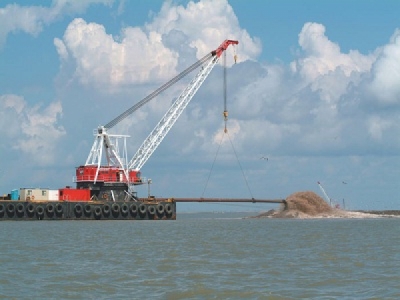
Posted on February 2, 2017
By Joseph Bonney, JOC.com
Now that Port Houston has finished dredging channels at its Bayport and Barbours Cut container terminals to 45-foot depth, the US Army Corps of Engineers is working to widen a curve to allow larger ships to enter and exit Bayport.
Work on the “Bayport flare” is expected to be finished by September, Mark Vincent, Port Houston’s director of channel development, said last week at a port-sponsored conference on synthetic resin shipments. The flare is a 72-acre area that is part of the Houston Ship Channel.
Port pilots said widening the curve from the Houston Ship Channel into the Bayport channel will provide access by ships measuring up to 1,160 feet long and 150 feet wide, compared with the current maximum of 1,096 feet wide and 143 feet wide.
Maximum draft for ships will remain 45 feet, matching the navigable depth of the ship channel. Rather than wait for federal funding, Port Houston decided to forgo the 75 percent federal matching funds for the deepening and to speed completion of the work by using some $80 million of its own funds to deepen the channels from their previous 40-foot depth.
Port officials said they decided to self-fund deepening of the spur channels to Barbours Cut and Bayport in order to keep channel capacity in line with the expanded capacity of the two terminals. Bayport is being expanded and Barbours Cut rebuilt to handle increased capacity.
Houston handles more than two-thirds of US Gulf container traffic. The port handled 842,089 twenty-foot-equivalent units of full imports in 2015 and 916,885 TEUs of exports during the 12 months from December 2014 through November 2015, according to PIERS, a sister company of JOC.com within IHS Markit.
Deepening the Bayport channel to 45 feet and widening it to 400 feet was completed in mid-December. Deepening the channel in front of the Barbours Cut was completed in 2015. As is standard in channel deepening projects, the channels were deepened a few feet beyond the official depth. The actual depth of the Barbours Cut and Bayport channels is 50.5 feet.
The work culminated a decades-long effort. In the dredging business, it’s often said that “a channel change represents a career,” Vincent noted.
The port secured authorization to deepen the lower part of the 52-mile Houston Ship Channel in the 1960s, but deepening to 45 feet wasn’t accomplished until 2005. The ship channel’s upper section, which ends at the turning basin docks used by breakbulk and project carriers, is 36 feet.
The water resources bill that Congress approved in early December included funds for the Corps to make navigation improvements including widening of the Bayport flare. The Corps has awarded a $26.6 million contract to Weeks Marine for widening the flare and using the dredged material to restore nearby marshes and to construction dikes for future disposal sites.
With completion of the Bayport channel deepening, ship pilots have been using a maritime training center at Covington, Louisiana, that has a 1/25 scale model of the channel to simulate handling of ships with capacities of up to 14,000 twenty-foot-equivalent units.
That’s far above the port’s current maximum capacity, but Houston officials are thinking ahead to the next phase of dredging. As local sponsor of the channel, the port authority is supporting a four-year Corps study of future improvements to the ship channel and its spurs to Bayport and Barbours Cut.
Among the proposals being examined are improvements to the container port channels, partial straightening of bends to allow larger ships, providing deeper drafts upstream on the ship channel, and creating an upper-bay anchorage that spares the need for pilots to shift chemical tankers and other vessels miles down the channel and back when no berth is open.
The channel improvements are designed to allow access by larger ships and to curtail the need for vessel pilots to perform a three-point turn known as “Texas chicken,” a tight passing maneuver in which approaching ships steer toward each other and then use each other’s wave pressure to separate their hulls as they pass close to each other.
Vincent said the study is scheduled to be completed by 2020 and is expected to produce an “attractive” benefit-to-cost ratio that would support federal appropriations to perform the work. He said that with luck, the next phase in the channel’s expansion “won’t take a full career.”
Source: JOC.com





